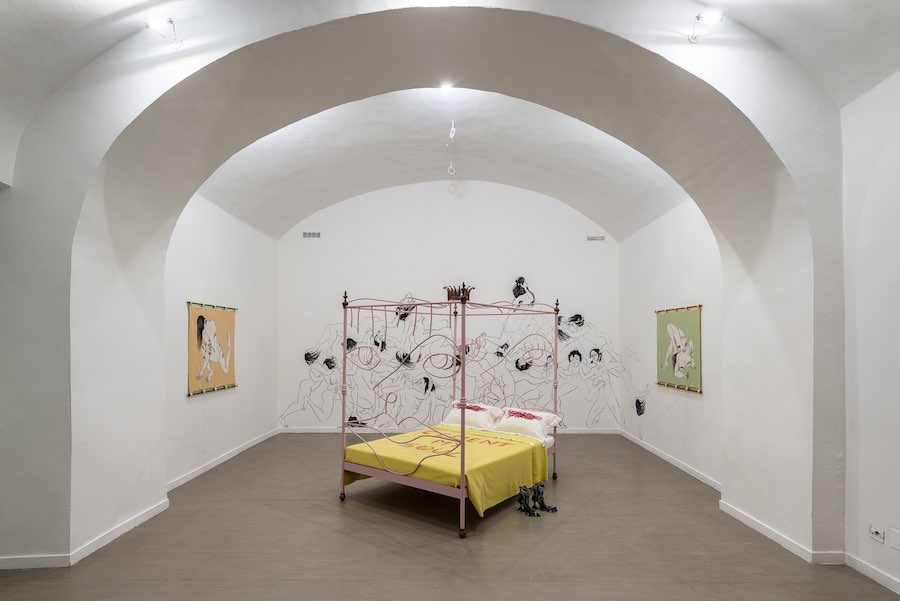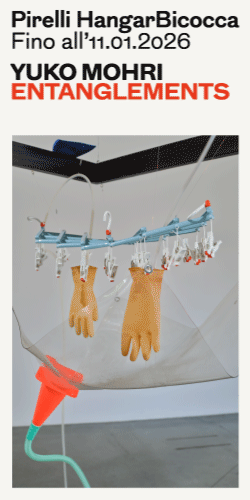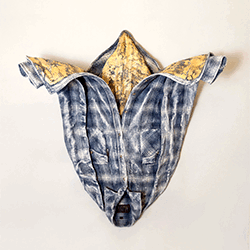
There is an anxiety of volition which is the result of a growing attention voted to new perspectives around female art and female artists. On the one hand, the body, with its voluptousness and centrality, is one of the main themes that lots of female-identifying artists are facing; on the other hand, there is a subtle and liminal way with which most of them are expressing their anxiety of volition, their attitutes, the different ways that inform their metodology, their practice and research. Dancing at the Edge of the World, curated by Marcelle Joseph at Sara Zanin Gallery, presents a wide selection of works, practices, materials, belonging to ten female-identifying artists – Saelia Aparicio, Charlotte Colbert, Monika Grabuschnig , Zsófia Keresztes, Alexi Marshall, Florence Peake, Lindsey Mendick and Paloma Proudfoot, Megan Rooney, Eve Stainton.
The choices of the curator are as interesting as
challenging: the exhibition re-creates a dialogic space in which every piece is
choosen for a specific vibe through which aesthetics, visual culture and
insights are perfeclty interrelated. The space of the exhibition is the space
of a performative body, both in its presence and in its absence. The gesture is
a sign of a volitive act performed over the body and over the mind.
As written by the curator, “In this
exhibition, to quote Le Guin one last time, these ten female-identifying
artists ‘dance[ ]… at the edge of things’ in order to rid the old
world of its populist, patriarchal tendencies that have persisted in the
oppression and othering of humans that lay outside a narrow demographic of
power and genius and to build a new world where marginalised communities are
not always on the verge of becoming but have become fully actualised humans
with all the rights and privileges of ‘Civilised Man’.”
In 1971, Gillo Dorfles spoke about Ketty La Rocca’s In Principio Erat by
using these powerfull words: “The language
of hands, talking hands, the gestures that reveal, that explain, that protect;
the deprecatory apotropaic – value of the gesture; the
imploring, the spell, the caress, the threat, the invitation, the refusal
[…]. Thus it is formed and gradually differentiated a code of gestures, first
spontaneous, then stereotyped, and finally crystallized by tradition, by
use”. In this exhibition, the refusal, the subversive content, the
expressions of the female body are equally interested by a codified language
with which verbal and non-verbal content are formulated and given to absorb the
viewer into a futuristic journey, made of dreams, unhead words and new
perspectives.
Interview by Angelica Gatto —
Angelica Gatto – “if you’re underneath, if you’re kept down, you break out, you subvert. We are volcanoes. When we women offer our experience as our truth, as human truth, all the maps change”. This is an interesting quote from Ursula K. Le Guin that you chose as an epigraph to your text for the group show curated at Sara Zanin Gallery in Rome. I would like to point out my attention on the verb “to subvert”. Which are the subversive modalities through which this exhibition comes to life?
Marcelle Joseph – In general, I believe that whenever women decide to speak up, take action or simply claim their space in our patriarchal world, they are embarking on an act of subversion. Two examples of subversive modalities in this exhibition are Saelia Aparicio’s wall mural which takes a woman’s ‘cat fight’ as its subject and Proudick’s designer shoe shop installation. I am interested in exploring what Ursula K. Le Guin calls ‘the mother tongue’, a language that is all about relations, networks and exchanges. Looking at Aparicio’s wall mural, the ‘father tongue’ has labelled a fight between women a ‘cat fight’, relegating women to an animal state or a kind of subhuman ‘otherness’. Battles among men are characterised in language as macho, courageous, brave or even chivalrous. This wall mural, in fact, could even be read as a group of women filled with feminine desire taking actions resultant in pleasure, taboo subjects in the ‘father tongue’ but in Le Guin’s words an ‘offer[ing of women’s] experience as [their] truth’. In the example of Proudick’s installation, the artists take the designer shoe shop – that quintessential haven of aspirational feminine desire – as their act of subversion, offering up another pleasure-filled activity of women. Women can be subversive feminists and enjoy shopping and bettering themselves through fashion and beauty products because, unlike the phallogocentric society we live in today that associates women only as an object or a body, the subversive feminist modalities of this exhibition see a woman’s body and mind inextricably connected together in a self- realising strategy of empowerment.

AG: Collecting and curating: in a certain way, these two approaches are interrelated in your curatorial practice. Is this aspect connected with the possibility to find a dialogue among very different visual approaches and aesthetics belonging to these ten females identifying artists chosen for the exhibition?
MJ . Alongside my curatorial practice, I do collect contemporary art by female artists in a voracious manner, much like the way the ten female-identifying artists in this exhibition make their art – voraciously and filled with purpose and meaning. I collect as part of a partnership called the GIRLPOWER Collection that acquires only work by female-identifying artists, and I collect more generally as part of my own personal collection. Slowly, over time, the collections’ focus has grown to encompassing the queer community of artists and artists of colour as an extension of feminist theory to queer and post-colonial theory. In the last ten years, I have amassed about 210 artworks by 144 artists, of which 70% of the artists belong to the communities of artists delineated above (i.e., all those folks marginalised by the patriarchal canon).
The majority of the artists in my collections I know or have worked with across my curatorial practice so collecting and curating have gone hand in hand. In fact, I look at my collection more as a collection of conversations with artists I admire for their skill, critical engagement and intellectualism. The thematic and aesthetic commonalities of my collection that overlap with this exhibition include an interest in materiality and the processes of making as well as the performativity of identity politics, often with a pinch of humour. The exhibition encompasses painting, drawing, printmaking, embroidery, sculpture and installation all made by the hands of these ten artists– from the ceramic and resin reliefs of Monika Grabuschnigg to the hand-embroidered linocut print of Alexi Marshall – so the works on display do indeed have a strong engagement with materiality and process. In terms of humour and identity politics, you need only look at Charlotte Colbert’s pastel pink flocked squash sculpture covered in female breasts with erect nipples or Zsófia Keresztes’ clown-like figurative sculpture made from thousands of pastel-hued mosaic tiles to discover a hint of humour alongside their examinations of process, materiality and the female lived experience. Of the ten artists in the exhibition, I have works by six of these artists in my collections.
AG: We Should All Be Feminists. In this exhibition the female body, which has been very central in diverse subversive feminist practices, is present but in a liminal way. Should we speak about a post-feminist approach? Which is the main difference between these contemporary practices and the previous ones?
MJ:Whether these works belong to a feminist or post-feminist canon, the different approaches to examining the female body undertaken by the artists in this exhibition do not differ greatly from their second-wave feminist forebears. Charlotte Colbert’s investigation of motherhood in her flocked sculptures in the show is no different from the concerns of Mary Kelly’s Post-Partum Document (1973-79). Similarly, Florence Peake’s works on paper that document the radical nude performances she choreographs and produces with her collaborator Eve Stainton can be seen in the same vein as the photographic self-portraits that Hannah Wilke’s partner Donald Goddard took of her in the space where she performed nude in So Help Me Hannah in 1978, radically narcissistic actions that were only considered feminist after Wilke’s premature death.
For the record, personally, I do not believe that we have entered a post-feminist mode of artistic production in light of the right-wing populist regimes that are coming to power around the world, trampling on the rights and protections of marginalised communities and allowing the myth of the Enlightenment Man and his power and genius to grow unfettered. Some of the works in the show may feature a more liminal suggestion of the female body, such as Megan Rooney’s The Lament (2019), but the absence of the female body or bodily trace in this work is just as strong as in Ana Mendieta’s Silueta series (begun in 1973) where Mendieta used an archetype of an abstracted feminine form – carving or shaping her figure into the earth – through which she hoped to access an ‘omnipresent female force’.

AG: On February 26th, Florence Peake and Eve Stainton will perform their Apparition Acts. Can you tell me something more about this and about the performative aspect that you chose to equally involve into the exhibition? I’m asking this because, in my opinion, there is a fluent and continuous performative aspect, the exhibition is like a stage and every work is there to re-enact something more visceral.
MJ-That’s great that you picked up on the performativity of the exhibition! After all, the title of the exhibition is ‘Dancing at the Edge of the World’. In exhibition making, I often think it is an excuse to create or envision another world, a utopia of sorts. This utopic world is filled with radically feminist humans that dance at the edge of things in order to create volcanoes that rid the old world of its populist, patriarchal tendencies.
On 26th February, Florence Peake and Eve Stainton will inhabit this utopic world with their own volcanic duet – the performance Apparition Acts that is a continuation of the performance they staged at the Venice Biennale last year. Using the intimacy of their lesbian polyamorous relationship to elevate the marginalised affection, sexuality, power and energy of the sensual and visceral queer body, Peake and Stainton will perform a ‘drawing score’ that invites audience members to make marks directly onto the artists’ own skin – a preparatory task for conjuring, initiating and imbuing the performing bodies into visibility. Peake and Stainton will then use Charlotte Colbert’s Art Bed, Sleep and Fairy Tales (2019)as a site/platform/stage for grappling with the charisma of materiality. I am hoping that it will be a performance that will live on in viewers’ memories for years to come, much like Yayoi Kusama’s early happenings in New York in the 70’s where performers painted their naked bodies with polka dots as a way to engage with the key issues of those times.










